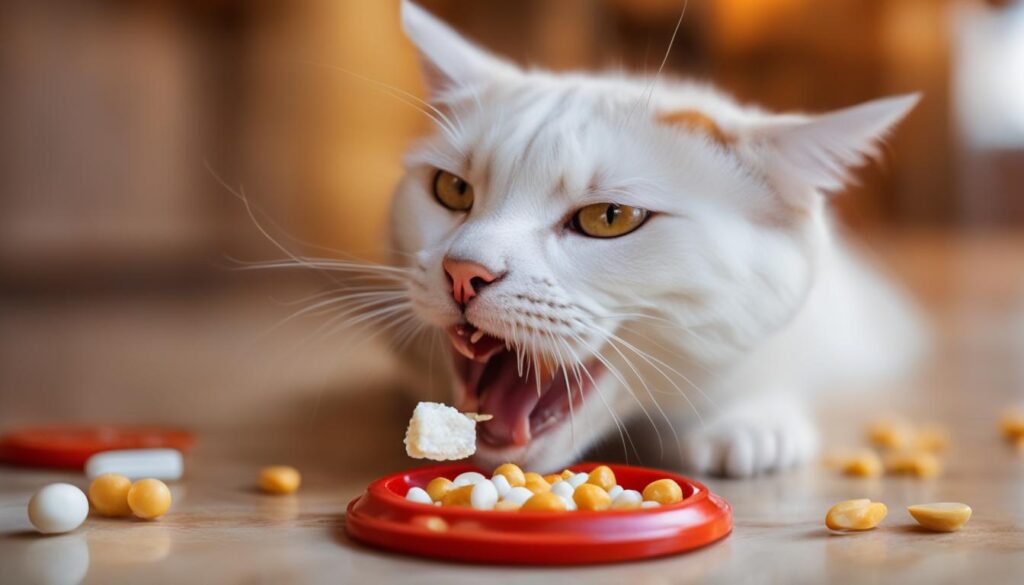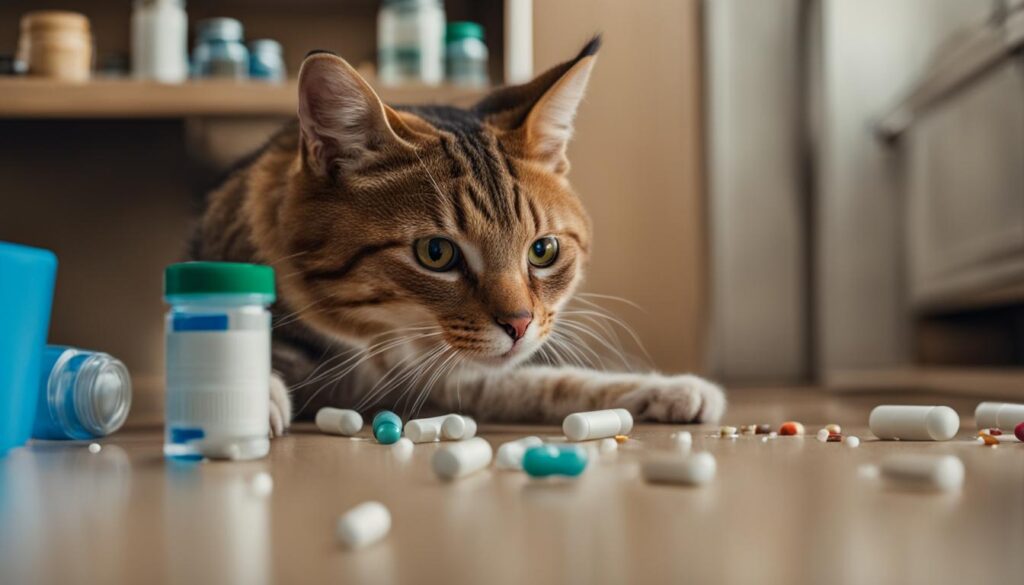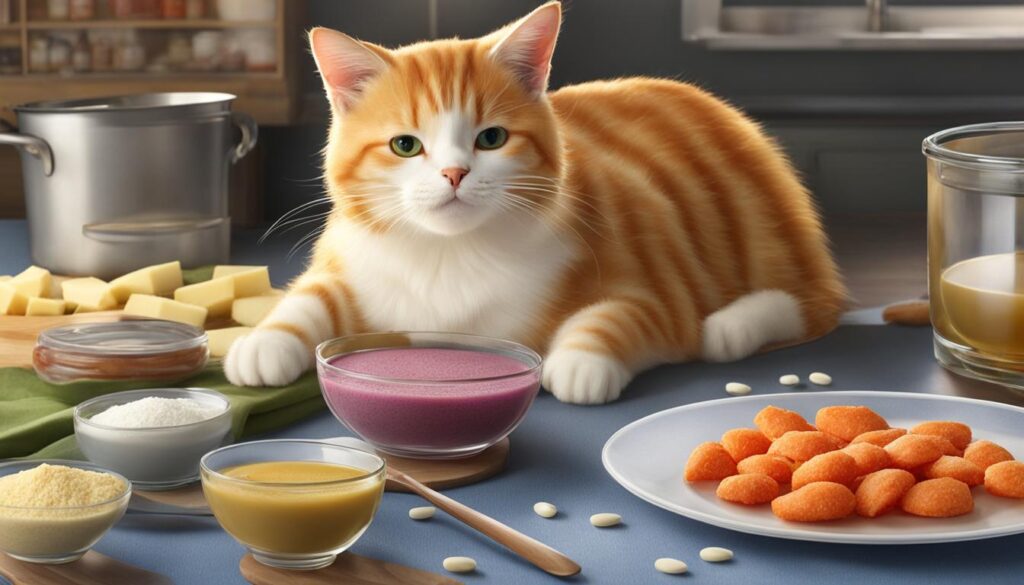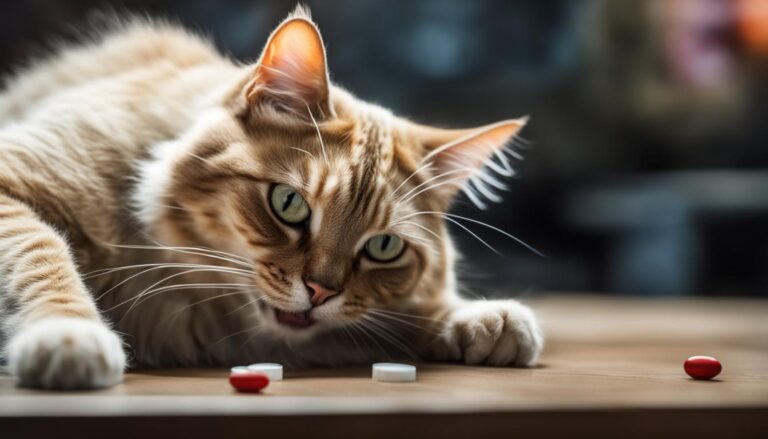Giving a cat a pill can be a challenging task for many cat owners. However, with the right techniques and tips, it is possible to make medication time less stressful for both you and your feline friend. In this article, we will explore various methods and strategies to successfully administer pills to cats, based on information from reputable sources such as I iz Cat and veterinarians.
Principais conclusões:
- Administering pills to cats can be a challenging task.
- Traditional methods may not always be effective.
- Alternative methods include using pill pushers and special techniques.
- Concealing pills in food can be another approach.
- Establishing a positive routine can make the process easier.
The Challenges of Giving a Cat a Pill
Giving pills to cats can be a daunting task, as many cat owners can attest. Traditional methods of directly placing the pill in the cat’s mouth can often result in a significant struggle. Cats are known for their resistance, attempting to spit out the pill or hide it in their mouth, adding to the difficulty of proper medication administration.
“Giving pills to cats can often feel like a battle,” says Nick Filippou from I iz Cat. This is why it’s important to explore alternative techniques and strategies to make the process less stressful for both you and your feline friend.
In order to effectively administer pills to cats, it’s essential to understand the challenges involved. By acknowledging the difficulties of giving a cat a pill, you can better prepare yourself and explore alternative methods that may lead to a successful pill-giving experience.
One effective approach is to consider the use of pill pushers or alternative methods like scuffing or popping the jaw open behind the back teeth. These techniques may help in safely and securely administering the pill without triggering resistance from the cat. However, it’s important to note that not all cats may respond positively to these methods, and it may require some trial and error to find the most suitable technique for your particular cat.
| Challenges of Giving a Cat a Pill | Alternative Techniques |
|---|---|
| Resistance to taking pills | Pill pushers |
| Spitting out or hiding the pill | Scuffing |
| Stressful for both the cat and owner | Popping the jaw open behind the back teeth |
It’s important to explore alternative techniques and strategies to make the process less stressful for both you and your feline friend.
By understanding the challenges and exploring alternative methods, you can increase the chances of successfully giving a pill to your cat. In the next section, we will delve into various alternative techniques, such as concealing the pill in food, that can help in alleviating the difficulties associated with pill administration.
Alternative Methods for Giving a Cat a Pill
Administering medication to cats can be a challenging task, but there are alternative methods that can help make the process easier and less stressful for both you and your feline friend. These tips and tricks can be particularly useful for cats who resist traditional pill administration techniques. Here are some alternative methods to consider:
1. Using a Pill Pusher
A pill pusher is a handy tool designed to safely deliver medication to your cat’s throat without causing discomfort. It consists of a plastic syringe with a soft rubber tip that holds the pill. By gently inserting the syringe into the back of your cat’s mouth and pushing the plunger, you can effectively administer the pill with minimal resistance. Remember to consult your veterinarian for guidance on correct usage and to ensure the pill pusher is suitable for your cat’s medication.
2. Special Techniques
In addition to using a pill pusher, there are other techniques that can make pill-giving easier. One such technique is scuffing, where you gently scratch your cat’s neck or chin to distract them while administering the pill. Wrapping your cat in a blanket or towel can also help keep them calm and immobilized during the process. Another effective technique is popping the jaw open behind the back teeth, creating a natural opening for the pill to be placed. However, it’s important to use caution and consult with a veterinarian or professional trainer for proper instruction on these techniques.
3. Seeking Professional Help
If all else fails, don’t hesitate to seek assistance from a veterinarian or professional pet sitter. These individuals have experience in handling and medicating cats and can provide guidance tailored to your specific situation. They may be able to offer alternative methods or provide demonstrations on how to effectively give your cat a pill.
Remember, every cat is unique, and what works for one may not work for another. It’s essential to be patient, observant, and adapt to your cat’s individual needs. With time and practice, you can find an alternative method that works best for both you and your furry companion.
| Method | Descrição |
|---|---|
| Pill Pusher | A plastic syringe with a soft rubber tip that allows for safe pill delivery to the cat’s throat. |
| Special Techniques | Scuffing, wrapping the cat in a blanket, or popping the jaw open behind the back teeth to facilitate pill administration. |
| Seeking Professional Help | Consulting a veterinarian or professional pet sitter for personalized guidance and assistance. |

One popular option is to use pill pockets specifically designed for cats. These pill pockets have a delicious coating that can easily be molded around the pill. Your cat will be enticed by the taste and texture, making it easier for them to swallow the medication without resistance. Alternatively, you can also try using canned fish such as tuna or soft pate-style cat foods to hide the pill. These strong-smelling and flavorful options can help mask the medication, making it more appealing to your cat.
Before using any food to conceal the pill, it is vital to consult with your veterinarian. They can provide guidance on which types of food are safe to use and ensure that the medication will still be effective when combined with these treats. Certain medications cannot be crushed or mixed with inappropriate substances, so it’s essential to follow professional advice to ensure your cat’s health and well-being.
| Pros of Concealing Cat Pills in Food | Cons of Concealing Cat Pills in Food |
|---|---|
| Easy and convenient method | Not all cats may be fooled by the taste or texture of the treat |
| Can be a more enjoyable experience for your cat | Some medications may not be suitable for ingestion with food |
| Pill pockets designed for cats are readily available | May require experimentation to find the right food to mask the medication |
By concealing the pill in food, you can turn medication time into a positive and rewarding experience for both you and your cat. Remember to consult with your vet, choose the right treats, and follow their instructions to ensure proper medication administration. With patience, practice, and the right approach, you can successfully give pills to your cat without stress or resistance.
Establishing a Positive Routine
When it comes to giving your cat a pill, establishing a positive routine is key. By creating a consistent schedule and introducing a tasty treat alongside the medication, you can help make the experience more pleasant for both you and your feline friend.
Start by selecting a specific time of day to give the pill, preferably when your cat is relaxed and in a calm environment. This could be during their regular feeding time or when they are most likely to be receptive to treats.
Next, introduce a tasty treat that your cat loves and associate it with the pill-giving time. Offer the treat for a few days without the pill, allowing your cat to form a positive association with receiving the treat. Then, gradually begin to incorporate the pill into the treat.
Here’s an example routine you can follow:
- Choose a consistent time of day for giving the pill, such as before breakfast or dinner.
- Offer your cat a small treat they enjoy, such as a piece of their favorite meat or a cat treat.
- Once your cat is eagerly accepting the treat, hide the pill inside it.
- Present the treat to your cat, allowing them to consume it without resistance.
- Continue this routine for the duration of the medication period, making sure to reward your cat with praise and additional treats after successfully taking the pill.
| Benefits of Establishing a Positive Routine | Challenges of Establishing a Positive Routine |
|---|---|
| Reduces resistance and stress during pill administration | Requires consistency and commitment |
| Enhances your cat’s receptiveness to medication | May take time for your cat to associate the pill with the treat |
| Strengthens your bond with your cat through positive reinforcement | Not suitable for all cats, particularly those with dietary restrictions |
Expert Tip
“The key to establishing a positive routine is patience and consistency. Be patient with your cat as they adjust to the routine and remember to always reward them for their cooperation. With time, your cat will become more receptive to taking the pill, making the process easier for both of you.” – Dr. Emily Collins, Feline Veterinarian

Homemade Pill Pocket Recipes
When it comes to giving your cat a pill, homemade pill pockets can be a creative and tasty solution. These homemade treats can help disguise the medication, making it easier for your feline friend to take their pills. Plus, you have the added benefit of knowing exactly what ingredients are going into your cat’s treat. Here are a few homemade pill pocket recipes that you can try:
Tuna Delight Pill Pockets
| Ingredients: | Instructions: |
|---|---|
| – 1 can of tuna in water, drained | 1. Mash the tuna in a bowl until it forms a paste. |
| – 1/4 cup of almond flour | 2. Gradually add almond flour to the mashed tuna, mixing well. |
| – 1 tablespoon of coconut oil | 3. Add coconut oil to the mixture, ensuring it is thoroughly combined. |
| – Optional: sprinkle of catnip or parsley | 4. If desired, add a sprinkle of catnip or parsley for added flavor. |
Once the mixture is ready, you can form small balls and use them as pill pockets. These tuna delight pill pockets can be stored in an airtight container in the refrigerator for up to a week.
Peanut Butter Bliss Pill Pockets
| Ingredients: | Instructions: |
|---|---|
| – 1/2 cup of almond butter | 1. In a bowl, combine almond butter and oats. |
| – 1/2 cup of oats | 2. Mix the ingredients together until well combined. |
| – 1 tablespoon of honey | 3. Add honey to the mixture, stirring until it forms a dough-like consistency. |
| – Optional: crushed cat treats | 4. For added flavor and texture, you can roll the dough in crushed cat treats. |
Once the dough is ready, you can shape it into small pockets and use them to conceal the pills. These peanut butter bliss pill pockets can be stored in an airtight container in the refrigerator for up to two weeks.
Remember, before introducing any new ingredients or treats into your cat’s diet, it is essential to consult with your veterinarian. They can provide guidance on the best options for your cat’s specific needs and ensure that the medications are still effective when given in a pill pocket. With these homemade pill pocket recipes, you can make pill administration a little easier and more enjoyable for both you and your feline companion.

Conclusão
Giving a cat a pill may seem like a daunting task, but with the right techniques and strategies, you can administer medication to your cat in a stress-free manner. By understanding the challenges and exploring alternative methods, such as concealing the pill in food and establishing a positive routine, you can successfully give pills to your feline friend.
Additionally, homemade pill pockets provide a creative and customizable option for making the pill-giving experience more enjoyable for both you and your cat. By using cat-safe ingredients, you can create tasty treats that disguise the pill, making it easier for your cat to consume. However, it is important to consult with a vet before introducing new ingredients into your cat’s diet, especially if your cat is on medication or has specific dietary restrictions.
Remember, patience, practice, and the right approach are key to mastering the art of giving a cat a pill. And always consult with your vet for specific guidance and recommendations tailored to your cat’s individual needs. With these tips and a positive attitude, you can ensure your cat’s healthcare needs are met while maintaining a strong bond with your feline companion.




